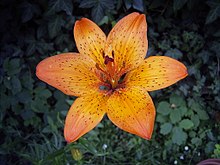Tepal

In flowering plants, the perigone or tepalum is a leaf of the pericarp , if the periculum is not divided into calyx and crown . This uniform flower envelope consisting of the same shape and color is called perigone or simple perianth .
Layout and function
The tepals fulfill both functions of the perianth, protection in the bud stage and attracting pollinators.
The tepals stand in one, two or more whorls or screw-like. The perigone can be single-circle, simple (haplo- or monochlamydeic) and (homoiochlamydeic), it can then be calyx-like (prophylloid, sepaloid), as in Juncus , Fagus or Rumex , or all tepals are corolla-like (petaloid, corolloid) like at the tulip .
In the Homoiochlamydeic, two- (dichlamydeic) or multi-circle, multiple perigone (pseudoperigon), the leaves in the inner and outer circle can also be different in size and shape (heterotepal), for example in the case of the snowdrop or the orchid family . A two-circle perigone is particularly common in monocots .
In the so-called heterotepal perigon, the tepals are formed differently. This difference often goes so far that the outer circle of tepals is already referred to as a crown, as is the case with many Commelinaceae or Bromeliaceae .
The individual tepals can be very large and conspicuously colored, like a crown or a petal (petaloid, corolloid, corollinian) z. B. with the tulip or anemone nemorosa , but they can also be small and inconspicuous, calyx-, vor-, bract-like (hypsophyll-, prophyll-, sepaloid) z. B. be at Scheuchzeria palustris .
If the tepals are completely or partially grown together, this is called syntepalie and if they are free, not grown, it is called chori- or apotepal .
Historical
Perigonium was introduced by Ehrhardt in the meaning of Perianth (cup and crown). Link used perigone for the uniform perimeter of the flower in 1798. It has been in use with this meaning ever since. The term Tepalum was introduced by Augustin Pyramus de Candolle in 1827 in analogy to the already common terms Petalum and Sepalum. It is a made-up word and formed as an anagram from petalum.
See also
- Minor crown or minor perigone
literature
- Joachim W. Kadereit, Christian Körner, Benedikt Kost, Uwe Sonnewald: Strasburger - Textbook of Plant Sciences. Springer Spectrum , 37th completely revised & updated edition, Berlin & Heidelberg 2014. ISBN 978-3-642-54434-7 (print); ISBN 978-3-642-54435-4 (eBook)
- Focko Weberling : Morphology of Flowers and Inflorescences. Cambridge Univ. Press, 1992, ISBN 0-521-25134-6 .
Individual evidence
- ^ A b c Manfred A. Fischer, Karl Oswald, Wolfgang Adler: Excursion flora for Austria, Liechtenstein and South Tyrol . 3rd, improved edition. Province of Upper Austria, Biology Center of the Upper Austrian State Museums, Linz 2008, ISBN 978-3-85474-187-9 , p. 93 f .
- ↑ a b Peter Leins, Claudia Erbar: Blossom and Fruit. Aspects of morphology, evolutionary history, phylogeny, function and ecology . Schweizerbart, Stuttgart 2000, ISBN 3-510-65194-4 , pp. 38-42 .
- ^ Gerhard Wagenitz : Dictionary of Botany. Morphology, anatomy, taxonomy, evolution. With English-German and French-German registers . 2nd expanded edition. Nikol, Hamburg 2008, ISBN 978-3-937872-94-0 , pp. 236, 326 (licensed edition 2003).
